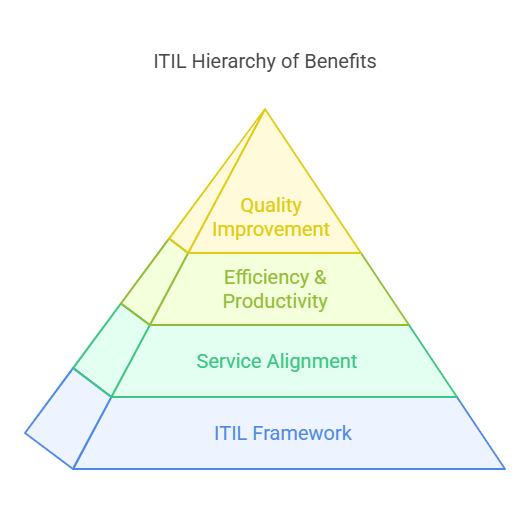The Information Technology Infrastructure Library (ITIL) is one of the most widely used frameworks for IT service management (ITSM). ITIL helps organizations align IT services with business needs, improving efficiency, productivity, and service quality. Professionals seeking ITIL certifications or IT service management roles should be well-prepared for ITIL-related interview questions.
This article covers the Top 25 ITIL Interview Questions and Answers to help you succeed in your interview.
1. General ITIL Interview Questions
Q1. What is ITIL?
Answer: “ITIL (Information Technology Infrastructure Library) is a framework that provides best practices for IT service management (ITSM). It focuses on aligning IT services with business needs, improving service delivery, and optimizing IT processes.”
Q2. What are the benefits of ITIL?
Answer: “The key benefits of ITIL include:
- Improved service quality and customer satisfaction
- Better resource utilization and cost-efficiency
- Enhanced risk management and compliance
- Streamlined IT processes and service delivery
- Increased collaboration between IT and business teams”
Q3. What are the five stages of the ITIL Service Lifecycle?
Answer: “The ITIL Service Lifecycle consists of:
- Service Strategy – Defines business objectives and customer needs.
- Service Design – Plans and designs IT services.
- Service Transition – Implements and deploys IT services.
- Service Operation – Manages day-to-day IT services.
- Continual Service Improvement (CSI) – Focuses on enhancing services over time.”
2. ITIL Framework and Processes
Q4. What is the difference between an incident and a problem in ITIL?
Answer: “An incident is an unplanned disruption to an IT service, while a problem is the underlying cause of one or more incidents. Incident management focuses on restoring services quickly, whereas problem management aims to identify and eliminate root causes to prevent recurrence.”
Q5. What is a Service Level Agreement (SLA)?
Answer: “An SLA (Service Level Agreement) is a contract between a service provider and a customer that defines the level of service expected, including response times, uptime guarantees, and performance metrics.”
Q6. What is Change Management in ITIL?
Answer: “Change Management is a process in ITIL that ensures all IT changes are implemented in a controlled and efficient manner. It minimizes risks, ensures proper planning, and prevents service disruptions.”
Q7. What is the purpose of a Configuration Management Database (CMDB)?
Answer: “A CMDB (Configuration Management Database) is a repository that stores information about IT assets (configuration items) and their relationships. It helps organizations track, manage, and control IT assets effectively.”
Q8. What is the role of an ITIL Service Desk?
Answer: “The Service Desk acts as the single point of contact between users and IT services. It handles incident management, service requests, and user inquiries, ensuring quick issue resolution and customer satisfaction.”
3. ITIL Roles and Responsibilities
Q9. What are the key roles in ITIL?
Answer: “Key ITIL roles include:
- Incident Manager – Manages incident resolution.
- Problem Manager – Identifies and resolves root causes of issues.
- Change Manager – Oversees change management processes.
- Service Desk Analyst – Handles user requests and incidents.
- Service Delivery Manager – Ensures IT services meet business needs.”
Q10. What is the role of a Problem Manager?
Answer: “A Problem Manager is responsible for identifying and eliminating root causes of recurring incidents, conducting root cause analysis, and implementing preventive measures.”
Q11. What is the difference between Service Request and Incident?
Answer: “A Service Request is a formal user request for standard IT services (e.g., password resets, access requests), whereas an Incident is an unplanned disruption that affects IT services.”
4. ITIL Key Concepts and Principles
Q12. What is the purpose of Continual Service Improvement (CSI)?
Answer: “CSI focuses on analyzing performance metrics, identifying areas for improvement, and implementing enhancements to improve IT services continuously.”
Q13. What is the 7-Step Improvement Process in ITIL?
Answer: “The 7-Step Improvement Process includes:
- Identify the strategy for improvement.
- Define what to measure.
- Gather the data.
- Process the data.
- Analyze the information.
- Present and use the information.
- Implement improvements.”
Q14. How does ITIL support Business-IT Alignment?
Answer: “ITIL ensures IT services align with business goals by focusing on customer needs, improving service quality, and ensuring cost-effective resource utilization.”
Q15. What are KPIs in ITIL?
Answer: “Key Performance Indicators (KPIs) in ITIL measure service performance, including metrics such as:
- Incident Resolution Time
- SLA Compliance Rate
- Change Success Rate
- Customer Satisfaction Score (CSAT)”
5. ITIL Certification and Career Growth
Q16. What ITIL certifications are available?
Answer: “The main ITIL certifications include:
- ITIL Foundation – Basics of ITIL concepts.
- ITIL Practitioner – Applying ITIL in real-world scenarios.
- ITIL Intermediate – Advanced ITIL processes.
- ITIL Expert – Comprehensive ITIL knowledge.
- ITIL Master – Highest level of ITIL certification.”
Q17. How can ITIL certification benefit your career?
Answer: “ITIL certification enhances job prospects, increases earning potential, and demonstrates expertise in IT service management, making professionals more valuable to organizations.”
Conclusion
ITIL plays a vital role in IT service management, ensuring efficient and high-quality service delivery. By preparing for these top 25 ITIL interview questions, candidates can confidently showcase their ITIL knowledge and increase their chances of landing an ITSM-related role.
Best of luck with your ITIL interview preparation!





